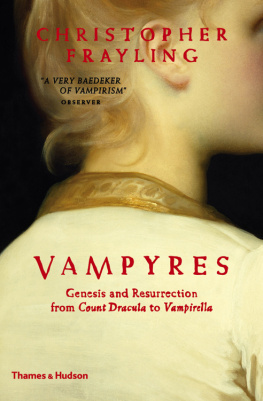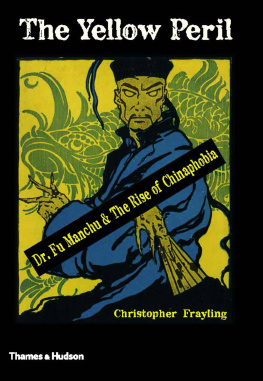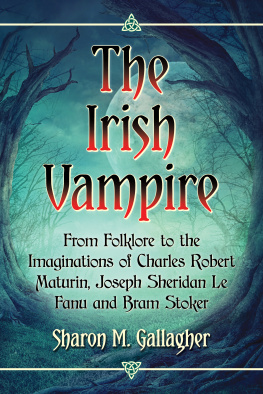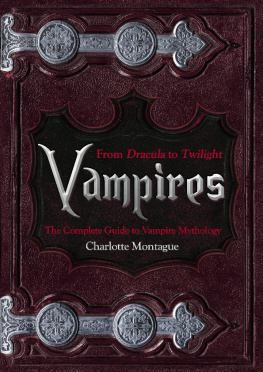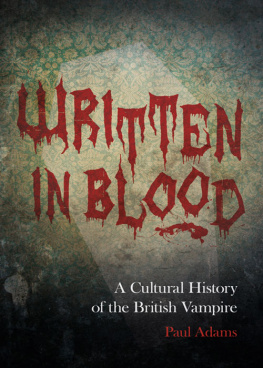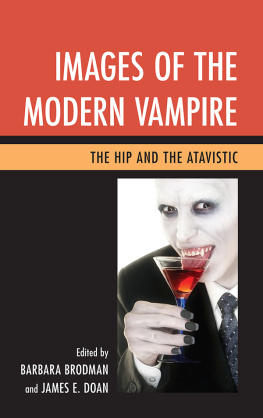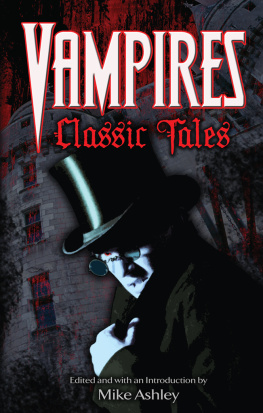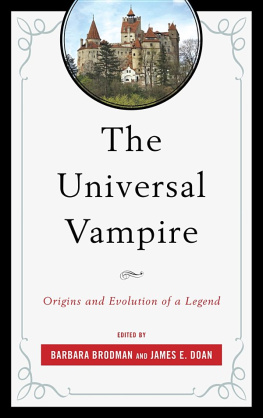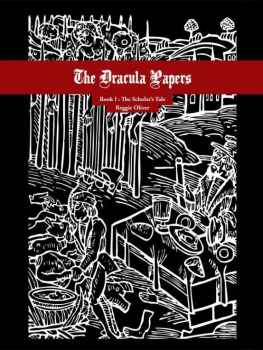Praise for earlier versions of Vampyres
The myth is endlessly adaptable, it will fit in with any culture and its preoccupations. It haunts the European imagination If you care to know in great detail how Bram Stoker put Dracula together what sources he consulted, what libraries he visited this is the book for you. Hilary Mantel, Daily Telegraph
Fraylings introduction is an outstanding piece of literary history: he has exhumed all kinds of quaint and curious lore with the indefatigable scholarly diligence of a Van Helsing, and his account of what he found among the dead men is perceptive, absorbing and witty Vampyres certainly has the power to grip and enlighten. Kevin Jackson, The Independent on Sunday
Allows the reader to trace, through the labyrinth of 19th-century popular fiction, the gradual emergence of our standard horror-film-type vampire The vampire-tales Frayling collects illustrate the richness of the genre and resurrect several lost gems A genuine contribution to vampire studies. John Carey, The Sunday Times
Christopher Fraylings engrossing theme is the dangerous night visitors, the nocturnal missionaries emissionaries one might almost call them of the Romantic twilight and the midnight glooms of Victorian repression Vampyres is a very Baedeker of vampirism a masterly guide-book. Valentine Cunningham, Observer
Vampyres is a capacious book dripping with suspense and replete with horror. Christopher Fraylings excellent introduction tracks the history of vampire treatises from the 18th century to Stokers 1897 classic The book is sharply written and incisively edited. Andrew St George, The Financial Times
Christopher Frayling has made a thorough scholarly survey of the vampiric literature of the 19th-century Gothic Revival The book is an enthralling anthology of excerpts from the works of vampirologists Fraylings cogent introductory and explanatory analyses are written with tongue-in-cheek zest: his own tongue, of course, in his own cheek. Patrick Skene Catling, Evening Standard
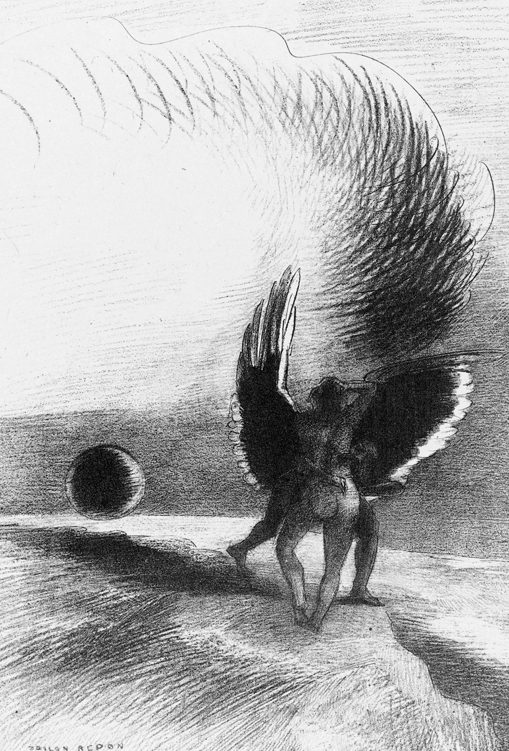
Odilon Redons dream lithograph of 1891 Beneath the Shadows Wing, the Black Creature was Biting Energetically.
About the Author
Sir Christopher Frayling is an eminent and wide-ranging cultural historian: the author of numerous publications on subjects ranging from Chinaphobia to Westerns; and the writer and presenter of successful television series, whether on advertising, Tutankhamun or Gothic nightmares. He is a Fellow of Churchill College, Cambridge, and was Rector of the Royal College of Art, London, from 1996 to 2009, where he remains Professor Emeritus of Cultural History. His many public appointments have included Chairman of Arts Council England; Chairman of the Design Council; and Trustee of the Victoria and Albert Museum.
Other titles of interest published by
Thames & Hudson include:
The Yellow Peril: Dr Fu Manchu & The Rise of Chinaphobia
Madness in Civilization: A Cultural History of Insanity from the Bible to Freud, from the Madhouse to Modern Medicine
Memento Mori: The Dead Among Us
Mythology: An Illustrated Journey into Our Imagined Worlds
See our websites
www.thamesandhudson.com
www.thamesandhudsonusa.com
CONTENTS
Joseph Pitton de Tournefort
Dom Augustin Calmet
John Polidori
Lord Byron
Alexandre Dumas
James Malcolm Rymer
Ernst Raupach
E. T. A. Hoffmann
Fitz-James OBrien
Alexis Tolstoy
Eliza Lynn Linton
Bram Stoker
Bram Stoker
: W. B. Yeats, James Joyce, T. S. Eliot
Angela Carter
References to bloodsuckers of various descriptions go right back to classical times, and in some myth cycles to the Garden of Eden. But the literary vampire was born two hundred years ago, in June 1816, in a holiday villa overlooking Lake Geneva. Incessant rain it was the worst summer on record encouraged Lord Byron, Percy Shelley, Mary Godwin and Dr John Polidori to scare each other with ghost stories late at night as a kind of family bet. After Mary Godwin had read out the operation scene of her Frankenstein, Lord Byron began a tale about a blue-blooded aristocrat who dies in a Turkish graveyard and promises to return. Some of the participants in the session had been reading about the vampires of folklore, and the still-active controversies surrounding the epidemics of vampirism which were said to have spread through peasant societies in Eastern Europe and Greece since the early eighteenth century. The story told by Lord Byron that night in June was subsequently rewritten and expanded by Dr Polidori, Byrons physician during the Geneva summer, and published without permission in 1819 under the title The Vampyre. Byron was furious. But it was too late to stem the flow. The Vampyre was a runaway bestseller, instantly copied and adapted for the stage. Not only did some editions of the story bear the tantalizing initials L. B. on the title page, but Goethe no less considered it the English poets finest work. The aristocratic literary vampire had been well and truly launched, with the best possible calling-card.
This book explores the bloodline of the literary vampire, from June 1816 back to the agricultural specimens who haunted the Age of Enlightenment, and forward to the novels, penny-dreadfuls, stories and poems that book-ended the century between The Vampyre (1819) and Bram Stokers Dracula (1897), still the most celebrated novel of them all. Usually, in fiction at any rate, the undead creatures tended to be aristocratic, sometimes male (loosely based on the mean, moody and magnificent image of Byron), sometimes the female of the species a more personalized form of sexual predator with a strawberry mouth, often originating in bohemian Paris. At the height of the Victorian craze, the art critic Walter Pater even saw a hint of the bloodsucker in the best-known portrait of a woman in Western art, Leonardos Mona Lisa: Like a vampire, she has been dead many times, and learned the secrets of the grave.
New elements had been added to the literary formula, new locations explored, new characteristics invented, new remedies tested as the century progressed. By the time Dracula was published, most pre-Freudian variations on the theme had been tried out one of the very first examples of the concerns of high culture being transmitted into the culture of the increasingly crowded and print-hungry inner cities, a special effect that lasted the best part of a century. An article in The Bookman magazine suggested that it was high time to get away from forests and castles and crucifixes and decadent aristos of both genders who liked their drink to be served at body temperature: We need horrors that survive modern plumbing and the brilliance of electric light.
Enter the cinematic vampire with Nosferatu (1922) and Dracula (1930) leading the card-carrying variety and, in printed form, the pulp magazines of the interwar years, the sci-fi vampires of the 1950s, the sado-sensual versions of the 1960s and early 1970s, Stephen Kings Salems Lot (1975), which has small-town America as its setting, and Anne Rices Interview with the Vampire (1976), which blends latter-day romanticism with a narrator-vampire, and gives one of the creatures an inner-life as an addict. The stage had by then been set for Buffy the Vampire Slayer
Next page
